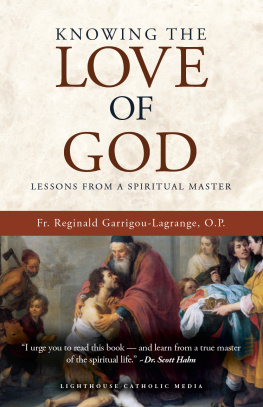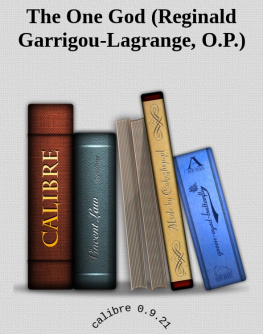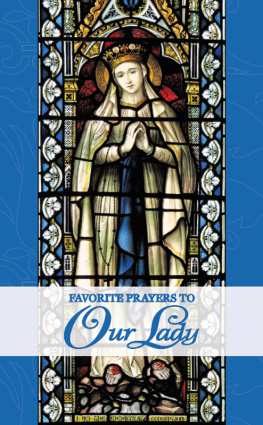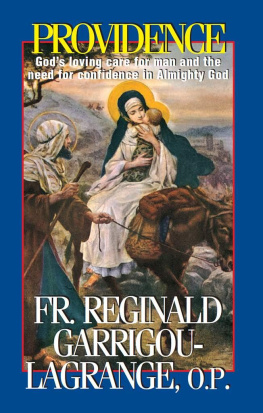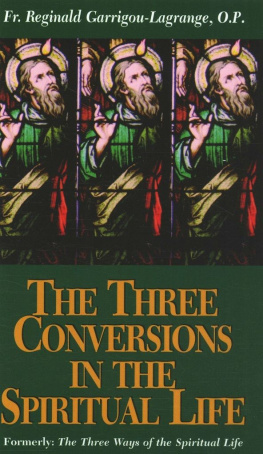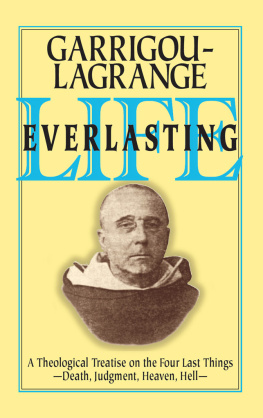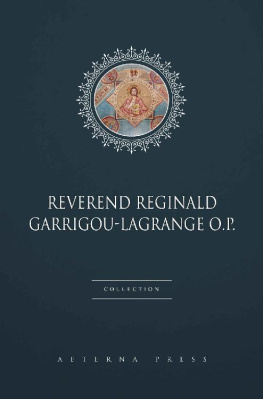CHRISTTHE SAVIOR
A Study of the Third Part of The Summa Theologica of St. ThomasAquinas
ReginaldGarrigou-Lagrange, O.P.
Editedby
PaulA. Ber, Sr.
VeritatisSplendor Publications
et cognoscetis veritatem etveritas liberabit vos
CopyrightNotice
Thecontents of Christ the Savior is in the public domain. However, this versionis copyrighted.
2012. Veritatis Splendor Publications.
AllRights Reserved.
DEDICATION
ADMAJOREM DEI GLORIAM
ForLynne, Paul, Margaret, Michael, Juan, and Lily
CONTENTS
Preface
We have already published treatises on the One God, the TriuneGod, the Creator, and the Holy Eucharist. These have been presented in the formof a commentary on the teaching of St. Thomas in his Theological Summa. It isthe purpose of the present treatise on Christ the Savior to explain, inaccordance with the more common interpretation of the Thomists, the teaching ofSt. Thomas on the motive of the Incarnation, the hypostatic union, and itseffects. We have discussed at length the more difficult problems, such as thereconciliation of freedom with absolute impeccability in Christ, theintrinsically infinite value of His merits and satisfaction, His predestinationwith reference to ours, inasmuch as He is the first of the predestined, and thereconciliation, during the Passion, of the presence of extreme sorrow withsupreme happiness experienced by our Lord in the summit of His soul.
In all these problems our wish has been to manifest the unity ofChrist inasmuch as He is one personal Being, although He has two reallydistinct and infinitely different natures. Hence the Person of Christconstitutes the one and only principle of all His theandric operations.
In all these questions St. Thomas, according to his custom,wonderfully preserved the principle of economy[1] by reducing all things to thesame principles and in the ultimate analysis to the one and only fundamentalprinciple. Similarly, with reference to the Passion everything is reduced tothe principle of the plenitude of grace. This plenitude, on the one hand, wasthe cause in the summit of our Lord's soul of the beatific vision and, on theother hand, it was the cause of His most ardent love as priest and victim, sothat He willed to be overwhelmed with grief, and die on the cross a mostperfect holocaust.
At the end of this treatise we have given merely a compendium onMariology, since a more complete commentary on this subject has recently beenpublished by us in the French language.
May the reading of these pages be a source of knowledge as well asof spiritual benefit to all students of theology.
THE THIRD PART OF STTHOMAS' THEOLOGICAL SUMMA
Prologue
In this prologue St. Thomas shows the place assigned to thistreatise in his Theological Summa, according to the division made by him at thebeginning of
this work, in which he had said: "Because the chief aim ofsacred doctrine is to teach the knowledge of God, not only as He is in Himself,but also as He is in the beginning of things and their last end, and especiallyof rational creatures... we shall treat:
(1) "Of God (one in nature and triune in persons, andinasmuch as He is the principle of creatures); (2) of the rational advance ofcreatures toward God (or of God as He is the end of the rational creature); (3)of Christ, who as man is our way to God."[2]
In the present treatise he says: "Because our Savior the LordJesus Christ in order to save His people from their sins, as the angelannounced, showed unto us in His own person the way of truth, whereby we mayattain to the bliss of eternal life by rising again, it is necessary... that,after consideration of the last end of human life, and the virtues and vices,there should follow a consideration of the Savior of all and of the benefitsbestowed by Him on the human race."[3]
Some theologians prefer another division to that made by StThomas, in which the distinction between dogmatic theology and moral theologyis more in evidence, so that moral theology is not placed between the treatiseson the One God and the Word incarnate. Furthermore, they remark that thetreatise on the Word incarnate because of its dignity justly comes immediatelyafter the treatise on the one and triune God.
To this the Thomists reply that, according to St. Thomas, dogmatictheology and moral theology are not two distinct sciences, but two parts of thesame science, similar to the science of God of which it is a participation.[4]The unity of this science results from the unity of its formal object both quodand quo.[5] Its formal object quod, or the subject of this science, is GodHimself considered in Himself, or as He is the principle and end of creatures.The formal object quo is virtual revelation by the light of which are deducedboth in dogmatic theology and moral theology the conclusions that are virtuallycontained in the revealed principles. Therefore dogmatic and moral theology arenot two sciences, but two parts of the same science.
They also remark that, although this treatise on the Savior,because of its dignity, precedes the moral part of theology, nevertheless, inthe orderly arrangement of knowledge, it is justly placed after the other partsof theology, and this especially for three reasons: (1) because the simplerthings come before the composite. In the preceding parts of the Summa, however,what pertains to God and to man are discussed separately, whereas the presenttreatise is concerned with Him who is both God and man.[6] (2) The work ofredemption presupposes also that man lived for a long period of time under thelaw of the Old Testament, as well as it presupposes acts of faith and othervirtues necessary in the various states of life. Hence St. Thomas appropriatelyplaces this treatise on the Savior at the end of his Summa. (3) Moreover, itmust be noticed that what is necessary precedes what is contingent. But in thetwo preceding parts of the Theological Summa, what forms the subject of specialdiscussion is the nature of God, and the nature of both angels and man withreference to God; whereas the Third Part of the Summa considers the greatcontingent fact which did not have to be realized, namely, that the Word wasmade flesh. This fact, although it is the greatest of all historical facts inthe universe, is a contingent fact; for it is not something absolutelynecessary, such as the divine nature for God and also the human nature for man.For this reason, certain philosophers, even certain mystics, desired to reachunion with God, not by way of Christ the universal mediator, although He hadsaid: "I am the way and the truth and the life."[7] These persons didnot grasp the practical import of the statement that Christ, or the Word of Godincarnate, is the exemplar and source of all virtues, without whom nobody canacquire salvation and sanctity.
This deviation from the common method of approach to God is initself manifestly in opposition to the great truth, namely, that these personssomehow overlooked the fact of the Incarnation, inasmuch as it is not anabsolutely necessary fact, and they failed to see that precisely because it iscontingent, it becomes, in some aspect, a fact of the greatest importance,inasmuch as it is a transcendent manifestation of God's most free andabsolutely gratuitous love for the human race. St. John testifies that: "Godso loved the world as to give His only-begotten Son."[8] He also says:"He hath first loved us, and sent His Son to be a propitiation for oursins."[9] In fact, these texts express the fundamental truth ofChristianity, which is that God, by a most free act of His love, sent Hisdivine Son to us. Hence the entire third part of the Theological Summa of St.Thomas is a detailed narrative of God's gratuitous love for us confirmed by thetext: "God so loved the world, as to give His only-begotten Son."[10]It is truly a complete description of this gratuitous love as being the motiveof God's mercy, and of the efficacy of this love. It is a canticle of God'sgratuitous love for the human race. Thus the contingency of this most prominentfact in the history of the human race does not lessen its importance, but itmanifests, on the contrary, the supreme gratuitousness of God's most free lovefor us.
Next page

